An Overview of the Current State of Cell Viability Assessment Methods Using OECD Classification
Abstract
1. Introduction
2. Cell Viability Methods
2.1. Structural Cell Damage (Non-Invasive)
2.2. Structural Cell Damage (Invasive)
2.3. Cell Growth
2.4. Cellular Metabolism
2.5. Membrane Potential
2.5.1. The Membrane Potential Cell Viability Assay (MPCVA)
2.5.2. The DD Cell-Tox Method
3. Discussion
4. Conclusions
5. Future Directions
Funding
Institutional Review Board Statement
Informed Consent Statement
Data Availability Statement
Conflicts of Interest
References
- Adan, A.; Kiraz, Y.; Baran, Y. Cell Proliferation and Cytotoxicity Assays. Curr. Pharm. Biotechnol. 2016, 17, 1213–1221. [Google Scholar] [CrossRef] [PubMed]
- Pognan, F.; Beilmann, M.; Boonen, H.C.M.; Czich, A.; Dear, G.; Hewitt, P.; Mow, T.; Oinonen, T.; Roth, A.; Steger-Hartmann, T.; et al. The evolving role of investigative toxicology in the pharmaceutical industry. Nat. Rev. Drug Discov. 2023, 22, 317–335. [Google Scholar] [CrossRef] [PubMed]
- Gordon, J.L.; Brown, M.A.; Reynolds, M.M. Cell-Based Methods for Determination of Efficacy for Candidate Therapeutics in the Clinical Management of Cancer. Diseases 2018, 6, 85. [Google Scholar] [CrossRef] [PubMed]
- Schreiber, S.L.; Kotz, J.D.; Li, M.; Aubé, J.; Austin, C.P.; Reed, J.C.; Rosen, H.; White, E.L.; Sklar, L.A.; Lindsley, C.W.; et al. Advancing Biological Understanding and Therapeutics Discovery with Small-Molecule Probes. Cell 2015, 161, 1252–1265. [Google Scholar] [CrossRef]
- Madorran, E.; Stozer, A.; Bevc, S.; Maver, U. In vitro toxicity model: Upgrades to bridge the gap between preclinical and clinical research. Bosn. J. Basic. Med. Sci. 2019, 20, 157. [Google Scholar] [CrossRef]
- Oltvai, Z.N.; Barabási, A.-L.; Jeong, H.; Tombor, B.; Albert, R. The large-scale organization of metabolic networks. Nature 2000, 407, 651–654. [Google Scholar]
- Galluzzi, L.; Pedro, J.M.B.-s.; Vitale, I.; Aaronson, S.A.; Abrams, J.M.; Adam, D.; Alnemri, E.S.; Altucci, L.; Andrews, D. Essential versus accessory aspects of cell death: Recommendations of the NCCD 2015. Cell Death Differ. 2015, 22, 58–73. [Google Scholar] [CrossRef]
- Riss, T.; Niles, A.; Moravec, R.; Karassina, N.; Vidugiriene, J. Cytotoxicity Assays: In Vitro Methods to Measure Dead Cells. In Assay Guidance Manual; Markossian, S., Grossman, A., Arkin, M., Auld, D., Austin, C., Baell, J., Brimacombe, K., Chung, T.D.Y., Coussens, N.P., Dahlin, J.L., et al., Eds.; Eli Lilly & Company and the National Center for Advancing Translational Sciences: Bethesda, MD, USA, 2004. [Google Scholar]
- OECD. Guidance Document on Good In Vitro Method Practices (GIVIMP); OECD Series on Testing and Assessment, No. 286; OECD Publising: Paris, France, 2018. [Google Scholar]
- Coppé, J.P.; Patil, C.K.; Rodier, F.; Sun, Y.; Muñoz, D.P.; Goldstein, J.; Nelson, P.S.; Desprez, P.Y.; Campisi, J. Senescence-associated secretory phenotypes reveal cell-nonautonomous functions of oncogenic RAS and the p53 tumor suppressor. PLoS Biol. 2008, 6, 2853–2868. [Google Scholar] [CrossRef]
- Liu, Y.; Cai, Z.; Li, N.; Alépée, N. How to facilitate the implementation of 3D models in China by applying good in vitro method practice for regulatory use. Front. Toxicol. 2023, 5, 1080528. [Google Scholar] [CrossRef]
- Seal, S.; Yang, H.; Vollmers, L.; Bender, A. Comparison of Cellular Morphological Descriptors and Molecular Fingerprints for the Prediction of Cytotoxicity- and Proliferation-Related Assays. Chem. Res. Toxicol. 2021, 34, 422–437. [Google Scholar] [CrossRef]
- Munoz, L.E.; Maueröder, C.; Chaurio, R.; Berens, C.; Herrmann, M.; Janko, C. Colourful death: Six-parameter classification of cell death by flow cytometry—Dead cells tell tales. Autoimmunity 2013, 46, 336–341. [Google Scholar] [CrossRef] [PubMed]
- Kühn, J.; Shaffer, E.; Mena, J.; Breton, B.; Parent, J.; Rappaz, B.; Chambon, M.; Emery, Y.; Magistretti, P.; Depeursinge, C.; et al. Label-free cytotoxicity screening assay by digital holographic microscopy. ASSAY Drug Dev. Technol. 2013, 11, 101–107. [Google Scholar] [CrossRef] [PubMed]
- Kasprowicz, R.; Suman, R.; O’Toole, P. Characterising live cell behaviour: Traditional label-free and quantitative phase imaging approaches. Int. J. Biochem. Cell Biol. 2017, 84, 89–95. [Google Scholar] [CrossRef] [PubMed]
- Louzao, M.C.; Ares, I.R.; Vieytes, M.R.; Valverde, I.; Vieites, J.M.; Yasumoto, T.; Botana, L.M. The cytoskeleton, a structure that is susceptible to the toxic mechanism activated by palytoxins in human excitable cells. Febs J. 2007, 274, 1991–2004. [Google Scholar] [CrossRef]
- Restrepo-Angulo, I.; De Vizcaya-Ruiz, A.; Camacho, J. Ion channels in toxicology. J. Appl. Toxicol. 2010, 30, 497–512. [Google Scholar] [CrossRef]
- Schroeder, A.B.; Dobson, E.T.A.; Rueden, C.T.; Tomancak, P.; Jug, F.; Eliceiri, K.W. The ImageJ ecosystem: Open-source software for image visualization, processing, and analysis. Protein Sci. 2021, 30, 234–249. [Google Scholar] [CrossRef]
- Zuba-Surma, E.K.; Kucia, M.; Abdel-Latif, A.; Lillard, J.W., Jr.; Ratajczak, M.Z. The ImageStream System: A key step to a new era in imaging. Folia Histochem. Cytobiol. 2007, 45, 279–290. [Google Scholar]
- Urbanska, M.; Muñoz, H.E.; Shaw Bagnall, J.; Otto, O.; Manalis, S.R.; Di Carlo, D.; Guck, J. A comparison of microfluidic methods for high-throughput cell deformability measurements. Nat. Methods 2020, 17, 587–593. [Google Scholar] [CrossRef]
- Devendran, C.; Carthew, J.; Frith, J.E.; Neild, A. Cell Adhesion, Morphology, and Metabolism Variation via Acoustic Exposure within Microfluidic Cell Handling Systems. Adv. Sci. 2019, 6, 1902326. [Google Scholar] [CrossRef]
- Kumar, P.; Nagarajan, A.; Uchil, P.D. Analysis of Cell Viability by the Lactate Dehydrogenase Assay. Cold Spring Harb. Protoc. 2018, 2018, pdb-prot095497. [Google Scholar] [CrossRef]
- Legrand, C.; Bour, J.M.; Jacob, C.; Capiaumont, J.; Martial, A.; Marc, A.; Wudtke, M.; Kretzmer, G.; Demangel, C.; Duval, D.; et al. Lactate dehydrogenase (LDH) activity of the cultured eukaryotic cells as marker of the number of dead cells in the medium [corrected]. J. Biotechnol. 1992, 25, 231–243. [Google Scholar] [CrossRef] [PubMed]
- Mishra, D.; Banerjee, D. Lactate Dehydrogenases as Metabolic Links between Tumor and Stroma in the Tumor Microenvironment. Cancers 2019, 11, 750. [Google Scholar] [CrossRef] [PubMed]
- Fotakis, G.; Timbrell, J.A. In vitro cytotoxicity assays: Comparison of LDH, neutral red, MTT and protein assay in hepatoma cell lines following exposure to cadmium chloride. Toxicol. Lett. 2006, 160, 171–177. [Google Scholar] [CrossRef] [PubMed]
- Galluzzi, L.; Aaronson, S.A.; Abrams, J.; Alnemri, E.S.; Andrews, D.W.; Baehrecke, E.H.; Bazan, N.G.; Blagosklonny, M.V.; Blomgren, K.; Borner, C.; et al. Guidelines for the use and interpretation of assays for monitoring cell death in higher eukaryotes. Cell Death Differ. 2009, 16, 1093–1107. [Google Scholar] [CrossRef] [PubMed]
- Van den Bossche, S.; Vandeplassche, E.; Ostyn, L.; Coenye, T.; Crabbé, A. Bacterial Interference With Lactate Dehydrogenase Assay Leads to an Underestimation of Cytotoxicity. Front. Cell Infect. Microbiol. 2020, 10, 494. [Google Scholar] [CrossRef]
- Farhana, A.; Lappin, S.L. Biochemistry, Lactate Dehydrogenase. In StatPearls; StatPearls Publishing LLC.: Treasure Island, FL, USA, 2024. [Google Scholar]
- Azqueta, A.; Stopper, H.; Zegura, B.; Dusinska, M.; Møller, P. Do cytotoxicity and cell death cause false positive results in the in vitro comet assay? Mutat. Res. Genet. Toxicol. Environ. Mutagen. 2022, 881, 503520. [Google Scholar] [CrossRef]
- Hu, W.; Culloty, S.; Darmody, G.; Lynch, S.; Davenport, J.; Ramirez-Garcia, S.; Dawson, K.; Lynch, I.; Doyle, H.; Sheehan, D. Neutral red retention time assay in determination of toxicity of nanoparticles. Mar. Environ. Res. 2015, 111, 158–161. [Google Scholar] [CrossRef]
- Fan, F.; Wood, K.V. Bioluminescent Assays for High-Throughput Screening. ASSAY Drug Dev. Technol. 2007, 5, 127–136. [Google Scholar] [CrossRef]
- Madorran, E.; Kocbek Šaherl, L.; Rakuša, M.; Takač, I.; Munda, M. Finding a Direct Method for a Dynamic Process: The DD (Direct and Dynamic) Cell-Tox Method. Int. J. Mol. Sci. 2024, 25, 5133. [Google Scholar] [CrossRef]
- Cho, M.H.; Niles, A.; Huang, R.; Inglese, J.; Austin, C.P.; Riss, T.; Xia, M. A bioluminescent cytotoxicity assay for assessment of membrane integrity using a proteolytic biomarker. Toxicol. In Vitro 2008, 22, 1099–1106. [Google Scholar] [CrossRef]
- Zhu, S.; Barbe, M.F.; Liu, C.; Hadjiargyrou, M.; Popoff, S.N.; Rani, S.; Safadi, F.F.; Litvin, J. Periostin-like-factor in osteogenesis. J. Cell. Physiol. 2009, 218, 584–592. [Google Scholar] [CrossRef] [PubMed]
- Pappenheimer, A.M. Experimental studies upon lymphocytes: I. the reactions of lymphocytes under various experimental conditions. J. Exp. Med. 1917, 25, 633–650. [Google Scholar] [CrossRef] [PubMed]
- Owen, S.C.; Doak, A.K.; Ganesh, A.N.; Nedyalkova, L.; McLaughlin, C.K.; Shoichet, B.K.; Shoichet, M.S. Colloidal drug formulations can explain “bell-shaped” concentration-response curves. ACS Chem. Biol. 2014, 9, 777–784. [Google Scholar] [CrossRef] [PubMed]
- Kuijpers, L.; van Veen, E.; van der Pol, L.A.; Dekker, N.H. Automated cell counting for Trypan blue-stained cell cultures using machine learning. PLoS ONE 2023, 18, e0291625. [Google Scholar] [CrossRef]
- Chiaraviglio, L.; Kirby, J.E. Evaluation of impermeant, DNA-binding dye fluorescence as a real-time readout of eukaryotic cell toxicity in a high throughput screening format. Assay. Drug Dev. Technol. 2014, 12, 219–228. [Google Scholar] [CrossRef]
- Foglieni, C.; Meoni, C.; Davalli, A.M. Fluorescent dyes for cell viability: An application on prefixed conditions. Histochem. Cell Biol. 2001, 115, 223–229. [Google Scholar] [CrossRef]
- Boyd, V.; Cholewa, O.M.; Papas, K.K. Limitations in the Use of Fluorescein Diacetate/Propidium Iodide (FDA/PI) and Cell Permeable Nucleic Acid Stains for Viability Measurements of Isolated Islets of Langerhans. Curr. Trends Biotechnol. Pharm. 2008, 2, 66–84. [Google Scholar]
- Inde, Z.; Rodencal, J.; Dixon, S.J. Quantification of drug-induced fractional killing using high-throughput microscopy. STAR Protoc. 2021, 2, 100300. [Google Scholar] [CrossRef]
- Darzynkiewicz, Z.; Bedner, E.; Traganos, F. Difficulties and pitfalls in analysis of apoptosis. Methods Cell Biol. 2001, 63, 527–546. [Google Scholar]
- Vitale, M.; Zamai, L.; Mazzotti, G.; Cataldi, A.; Falcieri, E. Differential kinetics of propidium iodide uptake in apoptotic and necrotic thymocytes. Histochemistry 1993, 100, 223–229. [Google Scholar] [CrossRef]
- Zamai, L.; Falcieri, E.; Marhefka, G.; Vitale, M. Supravital exposure to propidium iodide identifies apoptotic cells in the absence of nucleosomal DNA fragmentation. Cytometry 1996, 23, 303–311. [Google Scholar] [CrossRef]
- Madorran, E.; Stožer, A.; Arsov, Z.; Maver, U.; Rožanc, J. A Promising Method for the Determination of Cell Viability: The Membrane Potential Cell Viability Assay. Cells 2022, 11, 2314. [Google Scholar] [CrossRef] [PubMed]
- Castro-Concha, L.A.; Escobedo, R.M.; de Miranda-Ham, M.L. Measurement of Cell Viability in In Vitro Cultures. In Plant Cell Culture Protocols; Loyola-Vargas, V.M., Vázquez-Flota, F., Eds.; Humana Press: Totowa, NJ, USA, 2006; pp. 71–76. [Google Scholar]
- Kumar, P.; Srivastava, N.; Pande, M.; Prasad, J.K.; Sirohi, A.S. Evaluating Sperm Cell Viability and Membrane Integrity. In Protocols in Semen Biology (Comparing Assays); Srivastava, N., Pande, M., Eds.; Springer: Singapore, 2017; pp. 57–71. [Google Scholar]
- Michel, C.C. Chapter 9—Microvascular Permeability and the Exchange of Water and Solutes Across Microvascular Walls. In Seldin and Giebisch’s The Kidney, 5th ed.; Alpern, R.J., Moe, O.W., Caplan, M., Eds.; Academic Press: Cambridge, MA, USA, 2013; pp. 263–290. [Google Scholar]
- Heymann, E.; Mentlein, R.; Schmalz, R.; Schwabe, C.; Wagenmann, F. A method for the estimation of esterase synthesis and degradation and its application to evaluate the influence of insulin and glucagon. Eur. J. Biochem. 1979, 102, 509–519. [Google Scholar] [CrossRef] [PubMed]
- Kari, S.; Subramanian, K.; Altomonte, I.A.; Murugesan, A.; Yli-Harja, O.; Kandhavelu, M. Programmed cell death detection methods: A systematic review and a categorical comparison. Apoptosis 2022, 27, 482–508. [Google Scholar] [CrossRef] [PubMed]
- Ai, X.; Butts, B.; Vora, K.; Li, W.; Tache-Talmadge, C.; Fridman, A.; Mehmet, H. Generation and characterization of antibodies specific for caspase-cleaved neo-epitopes: A novel approach. Cell Death Dis. 2011, 2, e205. [Google Scholar] [CrossRef][Green Version]
- Bajt, M.L.; Cover, C.; Lemasters, J.J.; Jaeschke, H. Nuclear Translocation of Endonuclease G and Apoptosis-Inducing Factor during Acetaminophen-Induced Liver Cell Injury. Toxicol. Sci. 2006, 94, 217–225. [Google Scholar] [CrossRef]
- Rieger, A.M.; Nelson, K.L.; Konowalchuk, J.D.; Barreda, D.R. Modified annexin V/propidium iodide apoptosis assay for accurate assessment of cell death. J. Vis. Exp. JoVE 2011, 50, 2597. [Google Scholar] [CrossRef]
- Tang, H.M.; Talbot, C.C., Jr.; Fung, M.C.; Tang, H.L. Molecular signature of anastasis for reversal of apoptosis. F1000Research 2017, 6, 43. [Google Scholar] [CrossRef]
- Gao, J.; Xiong, A.; Liu, J.; Li, X.; Wang, J.; Zhang, L.; Liu, Y.; Xiong, Y.; Li, G.; He, X. PANoptosis: Bridging apoptosis, pyroptosis, and necroptosis in cancer progression and treatment. Cancer Gene Ther. 2024, 31, 970–983. [Google Scholar] [CrossRef]
- Kist, M.; Vucic, D. Cell death pathways: Intricate connections and disease implications. EMBO J. 2021, 40, e106700. [Google Scholar] [CrossRef]
- Vembadi, A.; Menachery, A.; Qasaimeh, M.A. Cell Cytometry: Review and Perspective on Biotechnological Advances. Front. Bioeng. Biotechnol. 2019, 7, 147. [Google Scholar] [CrossRef] [PubMed]
- Luk, H.-Y.; McFarlin, B.K.; Vingren, J.L. Using image-based flow cytometry to monitor satellite cells proliferation and differentiation in vitro. Methods 2017, 112, 175–181. [Google Scholar] [CrossRef] [PubMed]
- Flomerfelt, F.A.; Gress, R.E. Analysis of Cell Proliferation and Homeostasis Using EdU Labeling. Methods Mol. Biol. 2016, 1323, 211–220. [Google Scholar]
- Levkoff, L.H.; Marshall, G.P., 2nd; Ross, H.H.; Caldeira, M.; Reynolds, B.A.; Cakiroglu, M.; Mariani, C.L.; Streit, W.J.; Laywell, E.D. Bromodeoxyuridine inhibits cancer cell proliferation in vitro and in vivo. Neoplasia 2008, 10, 804–816. [Google Scholar] [CrossRef]
- Haskins, J.S.; Su, C.; Maeda, J.; Walsh, K.D.; Haskins, A.H.; Allum, A.J.; Froning, C.E.; Kato, T.A. Evaluating the Genotoxic and Cytotoxic Effects of Thymidine Analogs, 5-Ethynyl-2′-Deoxyuridine and 5-Bromo-2′-Deoxyurdine to Mammalian Cells. Int. J. Mol. Sci. 2020, 21, 6631. [Google Scholar] [CrossRef]
- Vichai, V.; Kirtikara, K. Sulforhodamine B colorimetric assay for cytotoxicity screening. Nat. Protoc. 2006, 1, 1112–1116. [Google Scholar] [CrossRef]
- Feoktistova, M.; Geserick, P.; Leverkus, M. Crystal Violet Assay for Determining Viability of Cultured Cells. Cold Spring Harb. Protoc. 2016, 2016, pdb.prot087379. [Google Scholar] [CrossRef]
- Mani, S.; Bharagava, R.N. Exposure to Crystal Violet, Its Toxic, Genotoxic and Carcinogenic Effects on Environment and Its Degradation and Detoxification for Environmental Safety. Rev. Environ. Contam. Toxicol. 2016, 237, 71–104. [Google Scholar]
- van Meerloo, J.; Kaspers, G.J.; Cloos, J. Cell sensitivity assays: The MTT assay. Methods Mol. Biol. 2011, 731, 237–245. [Google Scholar]
- Alépée, N.; Grandidier, M.H.; Cotovio, J. Sub-categorisation of skin corrosive chemicals by the EpiSkin™ reconstructed human epidermis skin corrosion test method according to UN GHS: Revision of OECD Test Guideline 431. Toxicol. In Vitro 2014, 28, 131–145. [Google Scholar] [CrossRef]
- Hamid, R.; Rotshteyn, Y.; Rabadi, L.; Parikh, R.; Bullock, P. Comparison of alamar blue and MTT assays for high through-put screening. Toxicol. In Vitro 2004, 18, 703–710. [Google Scholar] [CrossRef] [PubMed]
- Ghasemi, M.; Turnbull, T.; Sebastian, S.; Kempson, I. The MTT Assay: Utility, Limitations, Pitfalls, and Interpretation in Bulk and Single-Cell Analysis. Int. J. Mol. Sci. 2021, 22, 12827. [Google Scholar] [CrossRef] [PubMed]
- Wang, P.; Henning, S.M.; Heber, D. Limitations of MTT and MTS-based assays for measurement of antiproliferative activity of green tea polyphenols. PLoS ONE 2010, 5, e10202. [Google Scholar] [CrossRef] [PubMed]
- Kumar, A.; Rai, Y.; Bhatt, A.N. Anti-cancer drug-mediated increase in mitochondrial mass limits the application of metabolic viability-based MTT assay in cytotoxicity screening. Cytotechnology 2024, 76, 301–311. [Google Scholar] [CrossRef]
- Karakaş, D.; Ari, F.; Ulukaya, E. The MTT viability assay yields strikingly false-positive viabilities although the cells are killed by some plant extracts. Turk. J. Biol. 2017, 41, 919–925. [Google Scholar] [CrossRef]
- Rai, Y.; Pathak, R.; Kumari, N.; Sah, D.K.; Pandey, S.; Kalra, N.; Soni, R.; Dwarakanath, B.S.; Bhatt, A.N. Mitochondrial biogenesis and metabolic hyperactivation limits the application of MTT assay in the estimation of radiation induced growth inhibition. Sci. Rep. 2018, 8, 1531. [Google Scholar] [CrossRef]
- Damiani, E.; Solorio, J.A.; Doyle, A.P.; Wallace, H.M. How reliable are in vitro IC(50) values? Values vary with cytotoxicity assays in human glioblastoma cells. Toxicol. Lett. 2019, 302, 28–34. [Google Scholar] [CrossRef]
- Perelman, A.; Wachtel, C.; Cohen, M.; Haupt, S.; Shapiro, H.; Tzur, A. JC-1: Alternative excitation wavelengths facilitate mitochondrial membrane potential cytometry. Cell Death Dis. 2012, 3, e430. [Google Scholar] [CrossRef]
- Keil, V.C.; Funke, F.; Zeug, A.; Schild, D.; Müller, M. Ratiometric high-resolution imaging of JC-1 fluorescence reveals the subcellular heterogeneity of astrocytic mitochondria. Pflug. Arch. 2011, 462, 693–708. [Google Scholar] [CrossRef]
- Perry, S.W.; Norman, J.P.; Barbieri, J.; Brown, E.B.; Gelbard, H.A. Mitochondrial membrane potential probes and the proton gradient: A practical usage guide. Biotechniques 2011, 50, 98–115. [Google Scholar] [CrossRef]
- Zuang, V. The neutral red release assay: A review. Altern. Lab. Anim. 2001, 29, 575–599. [Google Scholar] [CrossRef] [PubMed]
- Ates, G.; Vanhaecke, T.; Rogiers, V.; Rodrigues, R.M. Assaying Cellular Viability Using the Neutral Red Uptake Assay. Methods Mol. Biol. 2017, 1601, 19–26. [Google Scholar] [PubMed]
- Seglen, P.O. Inhibitors of lysosomal function. Methods Enzymol. 1983, 96, 737–764. [Google Scholar] [PubMed]
- Strober, W. Trypan Blue Exclusion Test of Cell Viability. Curr. Protoc. Immunol. 2015, 111, A3.B.1–A3.B.3. [Google Scholar] [CrossRef]
- Davis, J.E.; Ludford-Menting, M.; Koldej, R.; Ritchie, D.S. Modified cell trace violet proliferation assay preserves lymphocyte viability and allows spectral flow cytometry analysis. Cytom. A 2024, 105, 394–403. [Google Scholar] [CrossRef]
- Sun, W.; Yang, J.; Zhang, Y.; Xi, Y.; Wen, X.; Yuan, D.; Wang, Y.; Wei, C.; Wang, R.; Wu, L.; et al. Exogenous H(2)S restores ischemic post-conditioning-induced cardioprotection through inhibiting endoplasmic reticulum stress in the aged cardiomyocytes. Cell Biosci. 2017, 7, 67. [Google Scholar] [CrossRef]
- Chazotte, B. Labeling nuclear DNA with hoechst 33342. Cold Spring Harb Protoc 2011, 2011, pdb.prot5557. [Google Scholar] [CrossRef]
- Wlodkowic, D.; Akagi, J.; Dobrucki, J.; Errington, R.; Smith, P.J.; Takeda, K.; Darzynkiewicz, Z. Kinetic viability assays using DRAQ7 probe. Curr. Protoc. Cytom. 2013, 65, 9–41. [Google Scholar] [CrossRef]
- Da Costa, R.; Redmann, K.; Schlatt, S. Simultaneous detection of sperm membrane integrity and DNA fragmentation by flow cytometry: A novel and rapid tool for sperm analysis. Andrology 2021, 9, 1254–1263. [Google Scholar] [CrossRef]
- Jannoo, R.; Xia, Z.; Row, P.E.; Kanamarlapudi, V. Targeting of the Interleukin-13 Receptor (IL-13R)α2 Expressing Prostate Cancer by a Novel Hybrid Lytic Peptide. Biomolecules 2023, 13, 356. [Google Scholar] [CrossRef]
- Wlodkowic, D.; Faley, S.; Darzynkiewicz, Z.; Cooper, J.M. Real-time cytotoxicity assays. Methods Mol. Biol. 2011, 731, 285–291. [Google Scholar] [PubMed]
- Gustafson, D.L.; Viola, L.O.; Towers, C.G.; Das, S.; Duval, D.L.; Van Eaton, K.M. Sensitivity of osteosarcoma cell lines to autophagy inhibition as determined by pharmacologic and genetic manipulation. Vet. Comp. Oncol. 2023, 21, 726–738. [Google Scholar] [CrossRef] [PubMed]
- Lee-MacAry, A.E.; Ross, E.L.; Davies, D.; Laylor, R.; Honeychurch, J.; Glennie, M.J.; Snary, D.; Wilkinson, R.W. Development of a novel flow cytometric cell-mediated cytotoxicity assay using the fluorophores PKH-26 and TO-PRO-3 iodide. J. Immunol. Methods 2001, 252, 83–92. [Google Scholar] [CrossRef] [PubMed]
- Neri, S.; Mariani, E.; Meneghetti, A.; Cattini, L.; Facchini, A. Calcein-acetyoxymethyl cytotoxicity assay: Standardization of a method allowing additional analyses on recovered effector cells and supernatants. Clin. Diagn. Lab. Immunol. 2001, 8, 1131–1135. [Google Scholar] [CrossRef]
- Yang, W.; Mu, B.; You, J.; Tian, C.; Bin, H.; Xu, Z.; Zhang, L.; Ma, R.; Wu, M.; Zhang, G.; et al. Non-classical ferroptosis inhibition by a small molecule targeting PHB2. Nat. Commun. 2022, 13, 7473. [Google Scholar] [CrossRef]
- Virág, L.; Kerékgyártó, C.; Fachet, J. A simple, rapid and sensitive fluorimetric assay for the measurement of cell-mediated cytotoxicity. J. Immunol. Methods 1995, 185, 199–208. [Google Scholar] [CrossRef]
- Masson-Meyers, D.S.; Bumah, V.V.; Enwemeka, C.S. A comparison of four methods for determining viability in human dermal fibroblasts irradiated with blue light. J. Pharmacol. Toxicol. Methods 2016, 79, 15–22. [Google Scholar] [CrossRef]
- Im, K.; Mareninov, S.; Diaz, M.F.P.; Yong, W.H. An Introduction to Performing Immunofluorescence Staining. Methods Mol. Biol. 2019, 1897, 299–311. [Google Scholar]
- Mfouo-Tynga, I.; Houreld, N.N.; Abrahamse, H. Evaluation of cell damage induced by irradiated Zinc-Phthalocyanine-gold dendrimeric nanoparticles in a breast cancer cell line. Biomed. J. 2018, 41, 254–264. [Google Scholar] [CrossRef]
- Lakshmanan, I.; Batra, S.K. Protocol for Apoptosis Assay by Flow Cytometry Using Annexin V Staining Method. Bio-Protoc. 2013, 3, e374. [Google Scholar] [CrossRef]
- Huang, Q.; Wang, L.; Ran, Q.; Wang, J.; Wang, C.; He, H.; Li, L.; Qi, H. Notopterol-induced apoptosis and differentiation in human acute myeloid leukemia HL-60 cells. Drug Des. Dev. Ther. 2019, 13, 1927–1940. [Google Scholar] [CrossRef] [PubMed]
- Peters, T.; Lindenmaier, H.; Haefeli, W.E.; Weiss, J. Interaction of the mitotic kinesin Eg5 inhibitor monastrol with P-glycoprotein. Naunyn-Schmiedeberg’s Arch. Pharmacol. 2006, 372, 291–299. [Google Scholar] [CrossRef] [PubMed]
- Ngamwongsatit, P.; Banada, P.P.; Panbangred, W.; Bhunia, A.K. WST-1-based cell cytotoxicity assay as a substitute for MTT-based assay for rapid detection of toxigenic Bacillus species using CHO cell line. J. Microbiol. Methods 2008, 73, 211–215. [Google Scholar] [CrossRef]
- Huyck, L.; Ampe, C.; Van Troys, M. The XTT cell proliferation assay applied to cell layers embedded in three-dimensional matrix. Assay. Drug Dev. Technol. 2012, 10, 382–392. [Google Scholar] [CrossRef]
- Bonnier, F.; Keating, M.E.; Wróbel, T.P.; Majzner, K.; Baranska, M.; Garcia-Munoz, A.; Blanco, A.; Byrne, H.J. Cell viability assessment using the Alamar blue assay: A comparison of 2D and 3D cell culture models. Toxicol. In Vitro 2015, 29, 124–131. [Google Scholar] [CrossRef]
- Desai, S.; Grefte, S.; van de Westerlo, E.; Lauwen, S.; Paters, A.; Prehn, J.H.M.; Gan, Z.; Keijer, J.; Adjobo-Hermans, M.J.W.; Koopman, W.J.H. Performance of TMRM and Mitotrackers in mitochondrial morphofunctional analysis of primary human skin fibroblasts. Biochim. Et Biophys. Acta (BBA)—Bioenerg. 2024, 1865, 149027. [Google Scholar] [CrossRef]
- Repetto, G.; del Peso, A.; Zurita, J.L. Neutral red uptake assay for the estimation of cell viability/cytotoxicity. Nat. Protoc. 2008, 3, 1125–1131. [Google Scholar] [CrossRef]
- Caldwell, J.C. Alterations in cell proliferation, cell death, or nutrient supply. In Tumour Site Concordance and Mechanisms of Carcinogenesis; Baan, R.A., Stewart, B.W., Straif, K., Eds.; International Agency for Research on Cancer: Lyon, France, 2019; Chapter 13. [Google Scholar] [PubMed]
- Zhao, J.; Yu, H.Q.; Ge, F.Q.; Zhang, M.R.; Song, Y.C.; Guo, D.D.; Li, Q.H.; Zhu, H.; Hang, P.Z. 7,8,3′-Trihydroxyflavone prevents doxorubicin-induced cardiotoxicity and mitochondrial dysfunction via activating Akt signaling pathway in H9c2 cells. Cell Signal 2023, 112, 110924. [Google Scholar] [CrossRef]
- Elmore, S. Apoptosis: A review of programmed cell death. Toxicol. Pathol. 2007, 35, 495–516. [Google Scholar] [CrossRef]
- Rainieri, S.; Conlledo, N.; Langerholc, T.; Madorran, E.; Sala, M.; Barranco, A. Toxic effects of perfluorinated compounds at human cellular level and on a model vertebrate. Food Chem. Toxicol. 2017, 104, 14–25. [Google Scholar] [CrossRef]
- Ettinger, A.; Wittmann, T. Fluorescence live cell imaging. Methods Cell Biol. 2014, 123, 77–94. [Google Scholar] [PubMed]
- Cai, Y.; Prochazkova, M.; Kim, Y.S.; Jiang, C.; Ma, J.; Moses, L.; Martin, K.; Pham, V.; Zhang, N.; Highfill, S.L.; et al. Assessment and comparison of viability assays for cellular products. Cytotherapy 2024, 26, 201–209. [Google Scholar] [CrossRef] [PubMed]
- Kumar, N.; Afjei, R.; Massoud, T.F.; Paulmurugan, R. Comparison of cell-based assays to quantify treatment effects of anticancer drugs identifies a new application for Bodipy-L-cystine to measure apoptosis. Sci. Rep. 2018, 8, 16363. [Google Scholar] [CrossRef] [PubMed]
- Mosieniak, G.; Sikora, E. Polyploidy: The link between senescence and cancer. Curr. Pharm. Des. 2010, 16, 734–740. [Google Scholar] [CrossRef]
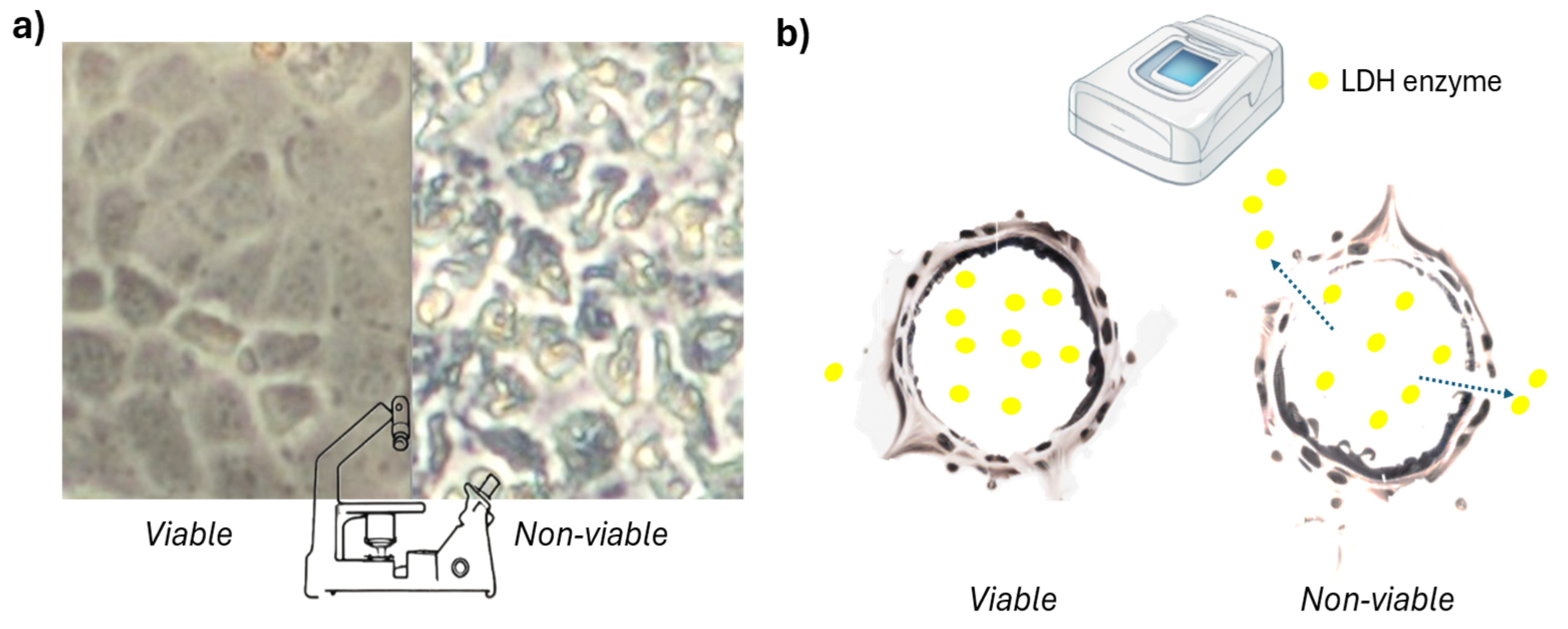
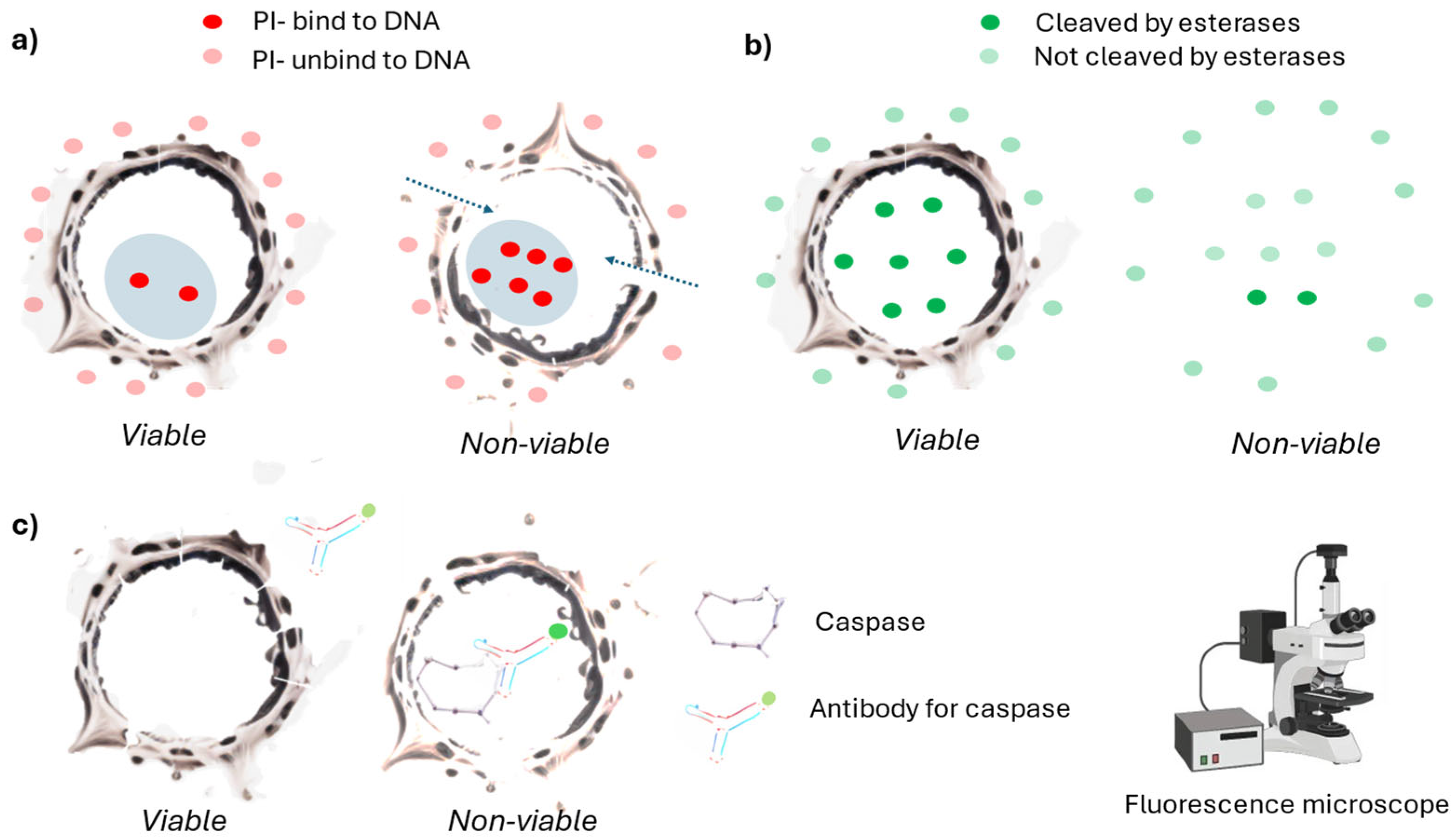
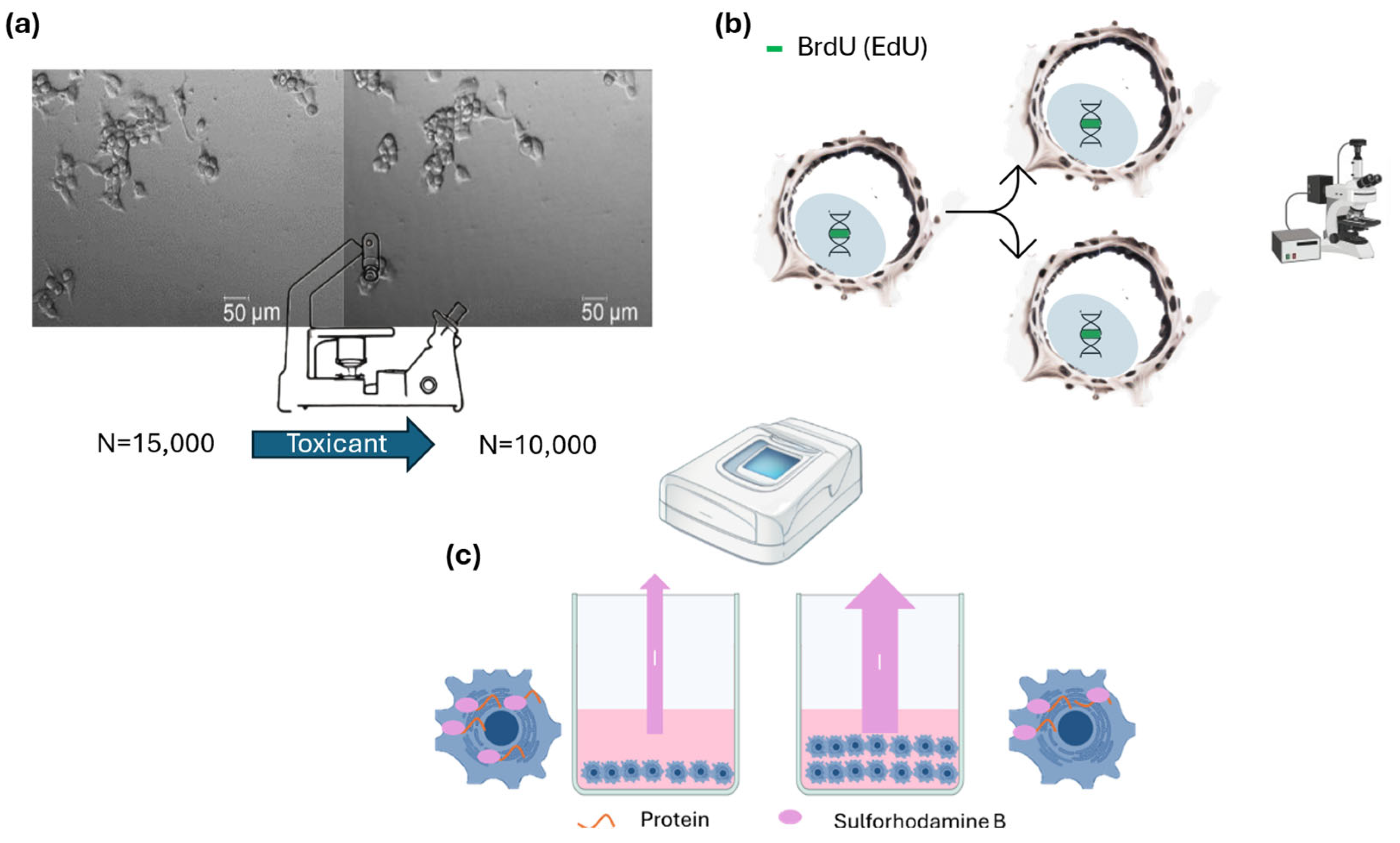
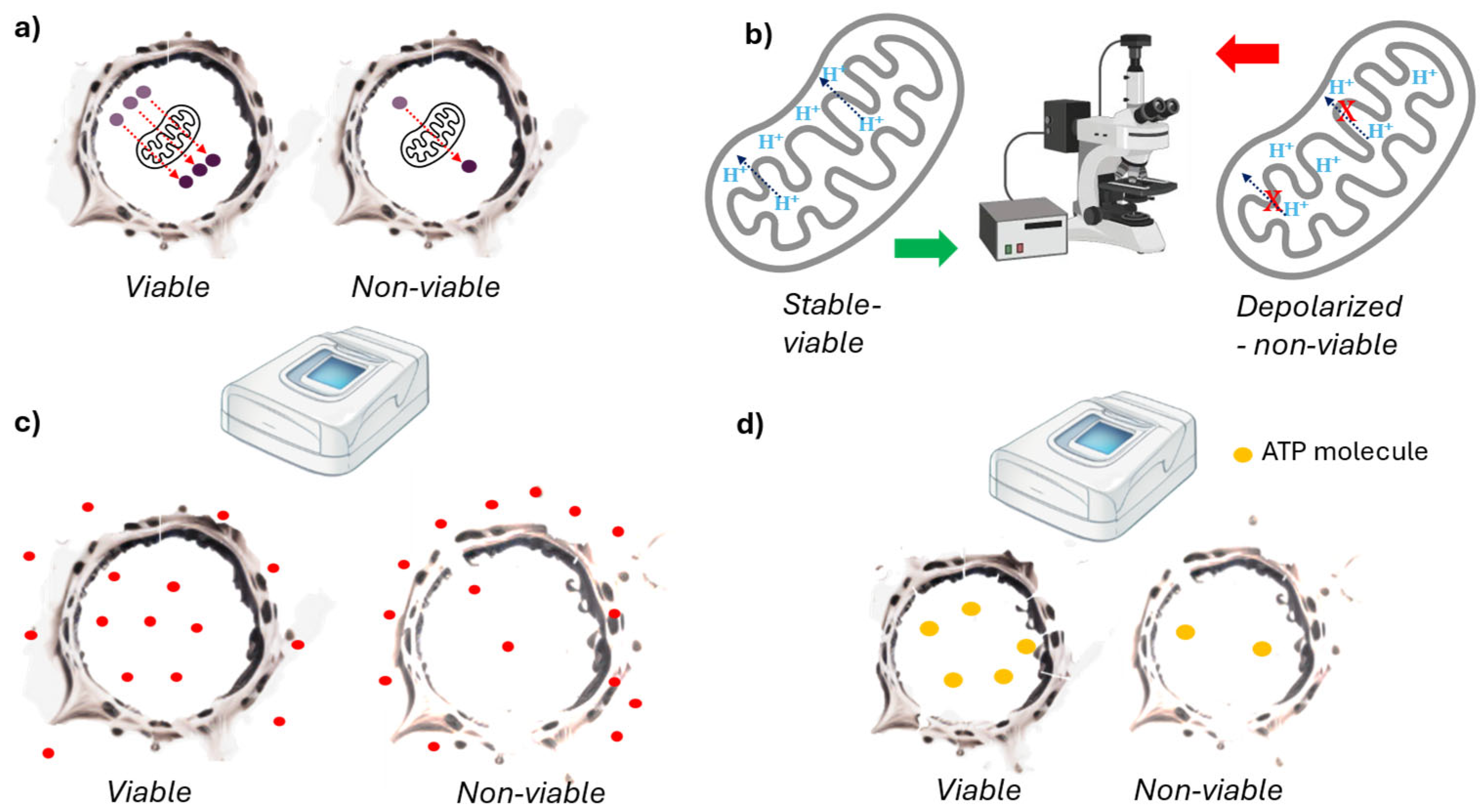
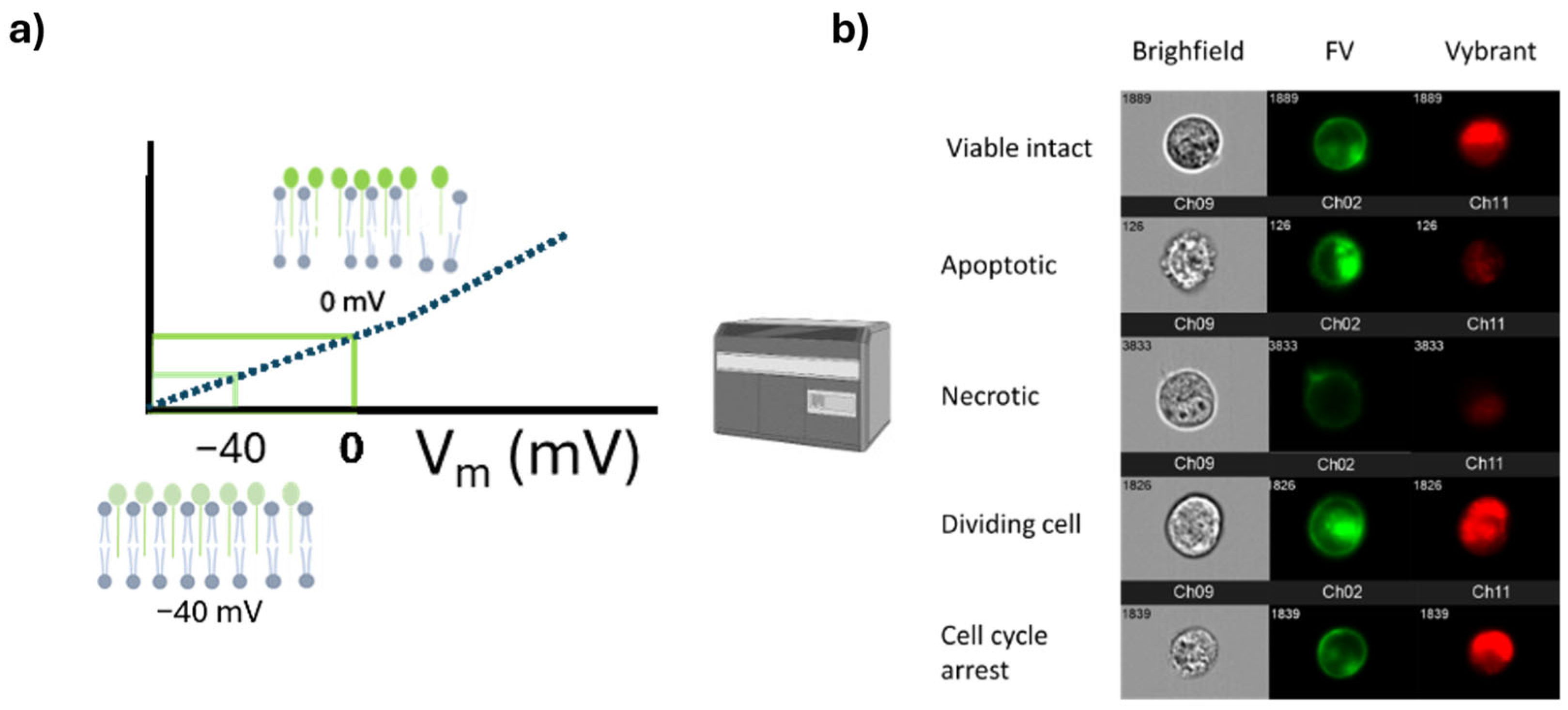
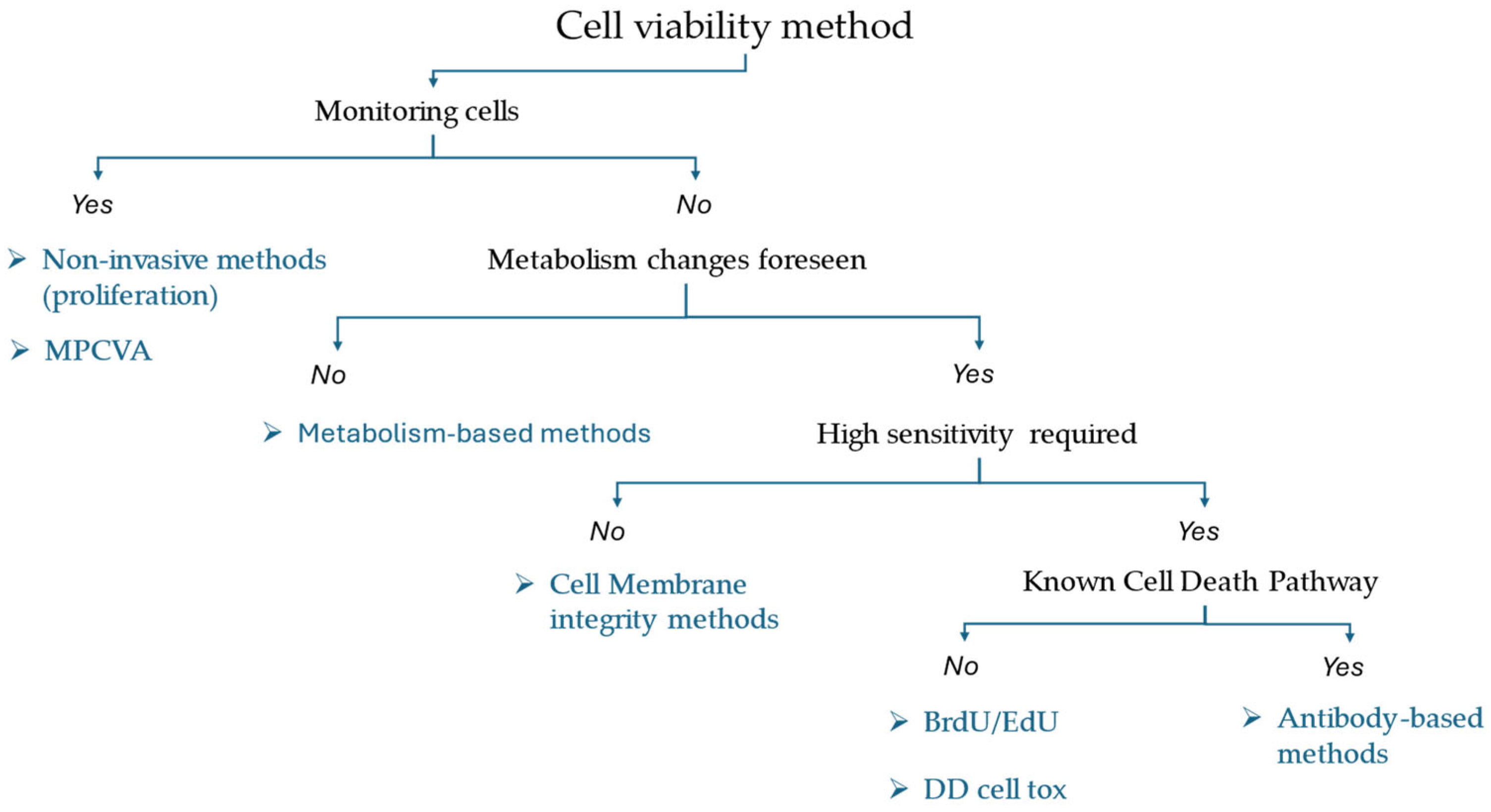
| Method (Group) | Principle | Endpoint (Instrument) | Advantages | Disadvantages |
|---|---|---|---|---|
| Structural cell damage (non-invasive) | ||||
| Optical microscope (1) | Changes in the morphology of the cell. | Observed changes in the morphology of the cell (optical microscope). | Quick, cheap, and it could be automatized. | Many artifacts affect the accuracy of the assay. |
| Release of intracellular compounds (2) | Measures the release of compounds into the cell culture medium due to damaged cell membrane. | Absorbance or luminescence of the compound (spectrophotometer or luminometer). | Quick, non-invasive. | High background level and potential false-positive events. |
| Structural cell damage | ||||
| Trypan blue (3) | Viable cells exclude the trypan blue dye. | Observation of stained cells (optical microscope). | Cheap, it could be automatized. | High rates of false positives and false negatives. |
| Lipid-soluble dyes (4) | Hydrolysis of the dye by intracellular esterase. | Fluorescence intensity of reduced products (fluorescence microscope, flow cytometer). | Quick, versatile (analysis of single cell or cell population in different instruments). | High rate of false positives. |
| Propidium iodide (5) | The dyes are impermeant only to live cells. | Fluorescence intensity of the internalized dye (fluorescence microscope, flow cytometer). | Quick, many references. | High rate of false positives. |
| Live/Dead assay (6) | It has two dyes: one impermeant only to live cells and the second is cleaved by esterases within the cell. | Fluorescence intensity of internalized dye and reduced dye (fluorescence microscope, flow cytometer). | Quick, versatile, better accuracy than single dyes alone. | High rate of false positives. |
| Antibodies to cell-death-associated pathways (7) | Determines the presence of molecules associated to cell death pathways. | Fluorescence intensity of the dye attached to the antibody (fluorescence microscope, flow cytometer). | Specific, determines the type of the programed cell death. | Expensive, unable to determine the viability of the cells with a different cell death pathway. |
| Cell growth | ||||
| Cell division (8) | Difference in cell number before and after the exposure. | Counting cell number in a population (microscope, flow cytometer, cell counter). | Cheap, accurate, and straightforward. | Time-consuming. |
| BrdU/EdU (9) | Daughter cells contained BrdU intercalated in their DNA. | Fluorescence intensity of BrdU (fluorescence microscope, flow cytometer). | High sensitivity no. | Toxic, impairs cell division. |
| Sulforhodamine B (SRB) and crystal violet (10) | The amount of dye is proportional to the cells (cell proliferation). | Absorbance of the dye (spectrophotometer). | Quick, cheap. | Toxic, measures cell mass, not cell viability. |
| Cellular metabolism | ||||
| MTT (11) | Reduction in the tetrazolium dye to formazan. | Absorbance of the formazan product (spectrophotometer). | Quick, cheap, high throughput, and many references. | Many artifacts affect the accuracy of the assay. |
| alamarBlue™ (12) | Resazurin reduction to resorufin. | Luminescence measurement of resorufin (fluorescence microscope and flow cytometer). | Quick, cheap, and high throughput. | Naturally occurring molecules disrupt the assay. |
| JC-1, TMRE, MitoTracker™ (13) | Mitochondrial membrane potential (lost in non-viable cells). | Fluorescence emission of the dye proportional to the mitochondrial membrane potential (fluorescence microscope and flow cytometer). | Fast, cheap, and high throughput. | Prone to bleaching, quenching, and unquenching. Accuracy issues in certain situations. |
| Neutral red (14) | Viable cells incorporate and bind the neutral red dye. | Absorbance of the incorporated dye (spectrophotometer). | Quick, cheap, and standardize. | Not a good correlation. Lysosomal activity affects its accuracy. |
| ATP production (15) | ATP production is correlated to cell viability. | Luminescence measurement of released ATP (luminometer). | Live imaging, non-invasive, and high throughput. | Many artifacts affect the accuracy of the assay. |
| Cell membrane potential | ||||
| MPCVA (16) | The cell membrane potential determines cell membrane integrity. | Fluorescence intensity of the dyes (fluorescence microscope, flow cytometer). | Direct determination, live imaging. | Not tested in various alternative situations. |
| DD Cell-Tox (17) | The cell membrane potential determines cell membrane integrity and DNA content in the doubling cells. | Fluorescence intensity of the dyes (fluorescence microscope, flow cytometer). | Direct determination, considers the cell population dynamics and the various outcomes triggered by toxic compounds. | Not tested in various alternative situations. Not suitable for long periods of cultivation. |
| Group | Method | References |
|---|---|---|
| 1 | Label-free imaging | [15] |
| 2 | LDH (Promega, Madison, WI, USA) | [23] |
| 2 | CytoToxTM (Promega, Madison, WI, USA) | [33] |
| 2 | Toxi-Light® (LONZA, Basel, Switzerland) | [33] |
| 2 | aCella™—TOX (Promega, Madison, WI, USA) | [33] |
| 2 | CyQUANT™ (Thermo Fisher Scientific, Waltham, MA, USA) | [34] |
| 3 | Trypan blue (MercK KGaA, Darmstadt, Germany) | [80] |
| 4 | CellTrace™ prolifereation kit (Thermo Fisher Scientific, Waltham, MA, USA) | [81] |
| 4 | Propidium iodide (MercK KGaA, Darmstadt, Germany) | [53] |
| 4 | Hoechst 33342 (Thermo Fisher Scientific, Waltham, MA, USA) | [82,83] |
| 4 | DRAQ7 (BD Biosciences, San Jose, CA, USA) | [84] |
| 4 | Acridine orange (Thermo Fisher Scientific, Waltham, MA, USA) | [85] |
| 4 | CellTox (Promega, Madison, WI, USA) | [86] |
| 4 | SYTOX (Thermo Fisher Scientific, Waltham, MA, USA) | [87] |
| 4 | YO-YO (Thermo Fisher Scientific, Waltham, MA, USA) | [88] |
| 4 | TO-PRO-3 Iodide (Thermo Fisher Scientific, Waltham, MA, USA) | [89] |
| 5 | Calcein AM (Thermo Fisher Scientific, Waltham, MA, USA) | [90] |
| 5 | CytoCalcein™ (Thermo Fisher Scientific, Waltham, MA, USA) | [91] |
| 5 | Propidium iodide (MercK KGaA, Darmstadt, Germany) | [92] |
| 6 | Live/Dead assay (Thermo Fisher Scientific, Waltham, MA, USA) | [93] |
| 7 | Antibodies | [94] |
| 7 | ApoTox-Glo (Promega, Madison, WI, USA) | [95] |
| 7 | Annexin V (Thermo Fisher Scientific, Waltham, MA, USA) | [96] |
| 8 | Cell division counting | [58] |
| 9 | BrdU assay (MercK KGaA, Darmstadt, Germany) | [59] |
| 9 | Edu assay (MercK KGaA, Darmstadt, Germany) | [59] |
| 10 | Sulforhodamine B (MercK KGaA, Darmstadt, Germany) | [97] |
| 10 | Crystal Violet (MercK KGaA, Darmstadt, Germany) | [98] |
| 11 | MTT assay (MercK KGaA, Darmstadt, Germany) | [65] |
| 11 | WST-1 assay (MercK KGaA, Darmstadt, Germany) | [99] |
| 11 | MTS assay (MercK KGaA, Darmstadt, Germany) | [8] |
| 11 | XTT assay (MercK KGaA, Darmstadt, Germany) | [100] |
| 12 | alamarBlue™ (Thermo Fisher Scientific, Waltham, MA, USA) | [101] |
| 13 | JC-1 (Thermo Fisher Scientific, Waltham, MA, USA) | [74] |
| 13 | TMRE (Thermo Fisher Scientific, Waltham, MA, USA) | [102] |
| 13 | MitoTracker™ (Thermo Fisher Scientific, Waltham, MA, USA) | [102] |
| 14 | Neutral red (MercK KGaA, Darmstadt, Germany) | [103] |
| 15 | ATP assay (Promega, Madison, WI, USA) | [8] |
| 16 | MPCVA | [45] |
| 17 | DD Cell-Tox | [32] |
Disclaimer/Publisher’s Note: The statements, opinions and data contained in all publications are solely those of the individual author(s) and contributor(s) and not of MDPI and/or the editor(s). MDPI and/or the editor(s) disclaim responsibility for any injury to people or property resulting from any ideas, methods, instructions or products referred to in the content. |
© 2024 by the authors. Licensee MDPI, Basel, Switzerland. This article is an open access article distributed under the terms and conditions of the Creative Commons Attribution (CC BY) license (https://creativecommons.org/licenses/by/4.0/).
Share and Cite
Madorran, E.; Ambrož, M.; Knez, J.; Sobočan, M. An Overview of the Current State of Cell Viability Assessment Methods Using OECD Classification. Int. J. Mol. Sci. 2025, 26, 220. https://doi.org/10.3390/ijms26010220
Madorran E, Ambrož M, Knez J, Sobočan M. An Overview of the Current State of Cell Viability Assessment Methods Using OECD Classification. International Journal of Molecular Sciences. 2025; 26(1):220. https://doi.org/10.3390/ijms26010220
Chicago/Turabian StyleMadorran, Eneko, Miha Ambrož, Jure Knez, and Monika Sobočan. 2025. "An Overview of the Current State of Cell Viability Assessment Methods Using OECD Classification" International Journal of Molecular Sciences 26, no. 1: 220. https://doi.org/10.3390/ijms26010220
APA StyleMadorran, E., Ambrož, M., Knez, J., & Sobočan, M. (2025). An Overview of the Current State of Cell Viability Assessment Methods Using OECD Classification. International Journal of Molecular Sciences, 26(1), 220. https://doi.org/10.3390/ijms26010220









